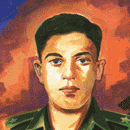|
 2nd Lieutenant Arun Khetarpal, son of Brigadier M.L. Khetarpal, was born on 14 October 1950, in Pune, Maharashtra. He was commissioned in the 17 Poona Horse on 13 June 1971. During the 1971 Indo-Pak War, the 47 Inf. Bde., with the 17 Poona Horse under command, was ordered to establish a bridge-head across the Basantar river in Shakargarh sector. The 47 Inf. Bde. completed the task by 2100 hours on December 15th. It was now for the engineers to breach the enemy mine-fields and make a safe lane for the induction of the 17 Poona Horse in support of the bridge-head. While the engineers were half way through their task, the Indian troops at the bridge-head reported alarming activity of the enemy Armour. 2nd Lieutenant Arun Khetarpal, son of Brigadier M.L. Khetarpal, was born on 14 October 1950, in Pune, Maharashtra. He was commissioned in the 17 Poona Horse on 13 June 1971. During the 1971 Indo-Pak War, the 47 Inf. Bde., with the 17 Poona Horse under command, was ordered to establish a bridge-head across the Basantar river in Shakargarh sector. The 47 Inf. Bde. completed the task by 2100 hours on December 15th. It was now for the engineers to breach the enemy mine-fields and make a safe lane for the induction of the 17 Poona Horse in support of the bridge-head. While the engineers were half way through their task, the Indian troops at the bridge-head reported alarming activity of the enemy Armour.
They requested immediate tank support. But the mine-field had been cleared only partially by that time. At this critical juncture, the 17 Poona Horse decided to push through the mine-field come what may. By first light on December 16th, the regiment established a link-up between the armour and the infantry at the bridge-head.
At 0800 hours, the enemy made a counter-attack with an armour regiment, under the cover of a smoke-screen. The target was the regimental pivot at Jarpal. As the Indians troops were heavily outnumbered, the Commander of 'B' Squadron requested reinforcement. At that time, 2nd Lt. Khetarpal was positioned close to the squadron with his troops in two tanks. He answered the call and moved out to face the enemy attack. On the way, his troops came under fire from enemy strong points and recoilless gun nests, in the bridge-head zone.
2nd Lt. Khetarpal fiercely attacked these strong-points, over-ran enemy defences and captured many enemy soldiers and recoilless guns at gun point. During one of these attacks, the commander of his second tank was killed on the spot leaving him alone. But he continued attack on the enemy strongholds single-handed, until all the enemy positions were overwhelmed. He then raced to the 'B' Squadron position. By the time he reached there, the enemy tanks were on the retreat. He pursued and destroyed one of these tanks. The 'B' Squadron Commander could persuade him to fall back in line after great difficulty.
The enemy soon reformed for a second attack. This time they chose the sector held by 2nd Lt. Arun Khetarpal and two other Officers, for the main attack. The enemy employed a complete armoured squadron against these three tanks in order to achieve a breakthrough. A fierce tank battle followed. As many as ten enemy tanks were destroyed and of these 2nd Lieutenant Khetarpal alone destroyed four. In the thick of the battle, two of the three Indian tanks became casualties - one was hit and another suffered mechanical failure.
The third tank, which was 2nd Lt. Khetarpal's tank, also received a shot and burst into flames. The Commander of the tank troops ordered 2nd Lt. Khetarpal to abandon the burning tank. But realising the useful role of his tank in preventing a breakthrough he communicated the following message to his Commander: "No Sir, I will not abandon my tank. My gun is still working and I will get these bastards." Then he set about destroying the remaining enemy tanks. The last enemy tank which he shot was barely 100 metres from his position. At this stage his tank received a second hit. The brave Officer met his death denying the enemy the intended breakthrough. For his conspicuous gallantry in the face of the enemy, 2nd Lt. Arun Khetarpal was honoured with the highest wartime gallantry medal, the Param Vir Chakra, posthumously. Jai Hind!! Jai Jawan!!

|